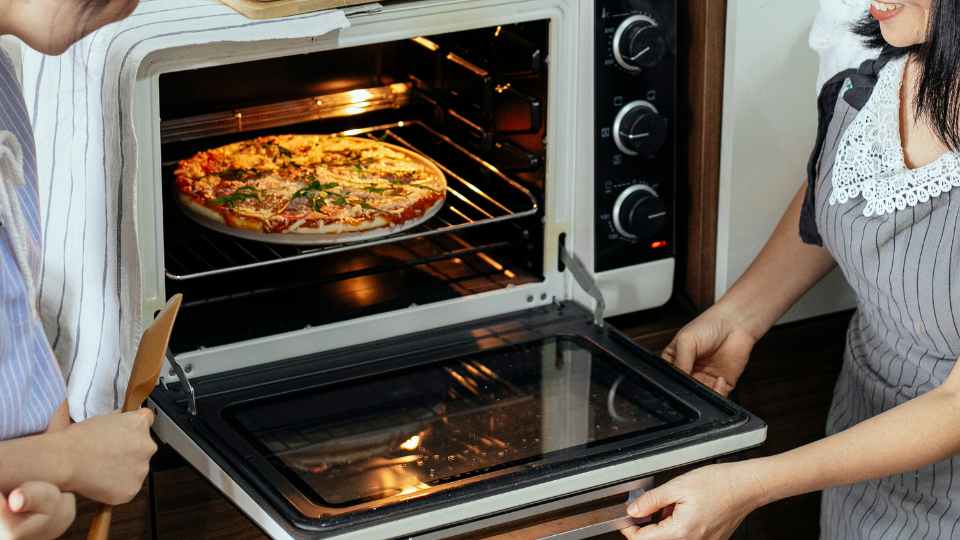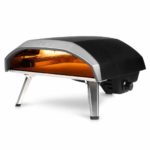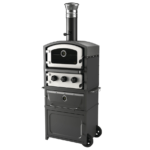What Oven Setting For Pizza Should I Use?
By Robert Parsons March 16th, 2023
It’s that time again – pizza night! You’ve got the ingredients, and now all you need to do is figure out what oven setting for pizza to use. Don’t worry; I’m here to help you out!
Making the perfect pizza at home isn’t as challenging as it may seem. Knowing how hot your oven needs to be and which setting will give you the best result sets up an evening of deliciousness.
With a few basic tips on which temperature and setting are right for your recipe, you can easily achieve restaurant-quality pizzas in no time.
Different types of oven settings you must know

There are various types of pizza oven settings that are worth knowing to achieve that perfect pizza every time.
Each setting caters to specific needs and preferences, ensuring the best possible outcome for your homemade pizza. Here, I would like to discuss some of these essential pizza oven settings that you must know to level up your pizza-making game.
1. Traditional Wood-Fired Oven Setting:
The most authentic method of cooking pizza, the wood-fired oven, gives you that amazing smoky flavour and crispy crust that can’t be replicated by other methods.
The high heat, reaching up to 900°F (480°C), allows the dough to puff up quickly, creating beautiful charred spots and bubbly cheese in a matter of minutes. As a fan of traditional Neapolitan pizza, this is my personal favourite!
2. Gas Pizza Oven Setting:
Providing a more consistent and easily controlled heat source than a wood-fired oven, gas ovens offer the convenience of cooking multiple pizzas simultaneously without worrying about fluctuating temperatures from burning logs.
The heat typically ranges between 750°F to 900°F (400°C to 480°C), ensuring a crispy, golden crust and gooey melted cheese.
3. Electric Pizza Oven Setting:
If you’re new to the homemade pizza scene, starting with an electric oven is practical, as it is easy to use, affordable, and requires minimal maintenance compared to its counterparts.
These ovens generally heat up to 500°F (260°C), making them suitable for thin-crust and deep-dish pizzas alike.
Just make sure to preheat the oven thoroughly before placing the pizza on a preheated pizza stone to replicate the high heat effect.
4. Convection Oven Setting:
Ideal for cooking multiple pizzas evenly, convection ovens circulate hot air throughout the oven, ensuring consistent heat distribution.
The temperature for convection ovens is often set around 475°F to 500°F (245°C to 260°C), which means a slightly longer cooking time compared to a wood-fired or gas oven, but it pays off with evenly cooked toppings and crust.
5. Pizza Stone or Pizza Steel Oven Setting:
Regardless of your oven type, investing in a pizza stone or pizza steel can elevate your pizza-making skills.
By retaining and distributing heat evenly, these tools create a perfectly crisp crust on the bottom, while allowing the toppings and cheese to cook thoroughly.
Just remember to preheat the stone or steel with the oven and ensure the temperature is around 475°F to 500°F (245°C to 260°C).
6. Rotating Oven Setting:
Pizzaiolos at commercial pizza parlours often rotate pizzas during the cooking process to ensure even cooking, especially in a wood-fired oven where hot spots may be present.
If your oven at home doesn’t have a rotating feature, you can simply turn the pizza halfway through the cooking process using a pizza peel or oven-safe plate to achieve similar results.
The importance of oven temperature for making pizza
I cannot emphasize enough the importance of oven temperature for making the perfect pizza.
Ensuring optimal heat while baking doesn’t only result in scrumptious tastes and textures, but it also plays a key role in chemical processes that bring out the best flavours in our beloved dish.
Let me delve deeper into the significance of this often-overlooked aspect of pizza-making.
First and foremost, the ideal oven temperature differs depending on the type of pizza being made. Generally speaking, traditional Neapolitan pizzas require an oven temperature of at least 900°F (about 480°C) for a rapid baking time of 60-90 seconds.
A more conventional homemade pizza, on the other hand, cooks best at around 475°F (about 250°C) for around 12-15 minutes. Striking the right temperature balance ensures that the crust remains crisp and the toppings are cooked evenly – leading to a mouthwatering final product.
A high oven temperature works wonders in creating a charred, smoky flavour for Neapolitan pizzas.
The intense heat quickly forms air bubbles in the dough, which contributes not only to a unique chewy texture but also results in those delectable little blisters that are synonymous with authenticity. This rapid cooking process helps lock in the flavours of the ingredients, making every slice a heavenly experience.
In terms of chemistry, browning reactions known as Maillard reactions take place when the dough is exposed to high temperatures. These reactions are responsible for imparting complex flavours to the crust, which becomes more flavorful and aromatic with each step of browning.
The Maillard reactions involve the reduction of sugars and amino acids, which ultimately gives rise to varying shades of golden-brown crustiness and a satisfying crunch.
It’s also important to take into consideration the type and quantity of toppings when determining oven temperature.
For pizzas with thicker toppings or denser ingredients, it’s best to lower the temperature slightly to allow for sufficient cooking without burning the crust. If you’re a fan of thin-crust pizza with minimal toppings, feel free to crank up the heat to achieve that delectable, crispy texture in a shorter time.
Tips on how to check if your pizza is done cooking correctly
Here are some detailed strategies and facts to help you with checking if your pizza is done cooking correctly:
1. Time and temperature:
Although these may sound like basic parameters, they are crucial to achieving a perfectly baked pizza. Most pizzas require 10-15 minutes of baking at about 475°F – 500°F (246-260°C).
However, different crust types and toppings may require adjustments to these standard settings. To be more precise, thin-crust pizzas bake for about 8-12 minutes, while thicker crusts require 12-15 minutes or more.
Pay attention to the recommendations on the pizza packaging or recipe and set a timer to ensure that you don’t overcook or undercook your pizza.
2. Visual cues:
Keep a close eye on your pizza as it bakes. The rim of your pizza should turn golden brown, and the cheese should be fully melted, bubbly, and slightly browned in spots.
Your pizza toppings should also appear cooked and not raw. Be mindful not to rely purely on appearances; it’s essential to also assess the texture and taste.
3. Crust crispiness:
A properly cooked pizza crust should ideally be firm and slightly crispy, depending on your thickness preference. Use a spatula or a fork to lift the edge of the pizza and tap the bottom crust.
If it sounds hollow and has a slightly stiff texture, the crust is cooked well. You can also use a pizza peel or a large spatula to slide under the pizza and lift it gently to check if it’s evenly cooked and not soggy.
4. Internal temperature:
This might not be as widely used in home cooking, but it’s a reliable way to determine if your pizza is fully cooked.
Insert an instant-read thermometer into the centre of the pizza (avoiding any toppings and the crust) and check for a temperature of 165°F (74°C) or higher, indicating that the dough and toppings are cooked through.
5. Taste test:
Ultimately, the best way to ensure your pizza is cooked the way you like is to taste it. Cut a small slice and check if the texture, flavour, and consistency suit your preferences.
If the crust isn’t crispy enough or if some toppings seem undercooked, pop the pizza back into the oven for a couple more minutes and adjust accordingly.
Conclusion
Creating restaurant-quality pizzas at home is surprisingly achievable with a few simple steps.
Using the right temperature and setting for your oven is essential for making an irresistible pizza. Even if you’ve never made a homemade pizza before, why not take the plunge and give it a try?
Who knows – you may find yourself as the proud creator of delicious homemade pies each and every week! And with your newfound knowledge about pizza oven settings, you’ll be able to make all kinds of delicious creations tailored to your own unique tastes in just minutes.
So why not take the plunge today? With just a few simple steps, you can make restaurant-quality pizzas from the comfort of your own kitchen.






